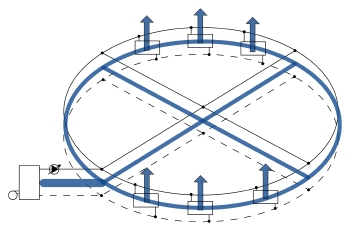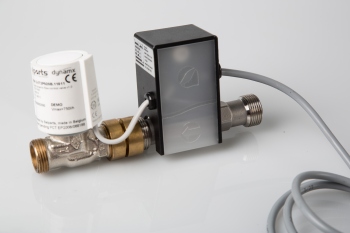Evolving pipework

There have been many ways of delivering water to heating and cooling units over the years, al with the aim of ensuring that systems can always be optimised and needs are always met. Martin Lowe of Marflow Hydronics looks at what might come next.
As with many things in life, pipe layouts have had to evolve to meet the requirements for heating and cooling. Going back many years, the first attempt to distribute water through a building was with a single-pipe system — with very large boilers, large pipework and large radiators; they took days to warm up. Using convection currents and relying on water density for circulation was inefficient, costly and depended on predicting the weather three days in advance.
Once effective water flow to terminal devices was established, temperature control was required to avoid over-heating, and thermostatic radiator valves were introduced. The introduction of forced water circulation meant boilers could reduce their water content, and pipework developed into two pipes — flow and return.
The 2-pipe system eased the design and sizing of the water distribution system, but evenly distributing the flow to each terminal unit then became a problem. This meant further methods needed to be introduced to simplify the commissioning process. Another system was then developed to ease the amount of balancing required, and this was the reverse-return system.
 |
| The future of pipework systems — a thermal grid with flow to a terminal unit possibly coming from two directions. The benefits includes easier control and lower energy use. |
As we have gone through time, there has had to be an evolution of pipework layouts to ensure that the needs of a building can be met. It is this constant innovation which has been vital to keep our systems optimised.
When designing a system we are given certain rules that will deliver a particular accepted solution. Flow rates, pressure drops and pipework size are all taken into consideration at an early stage. There are further rules regarding installation, cleaning and balancing. Finally comes best practice, which helps to avoid simple problems of air, circulation and reductions in flow.
The rules are the guidelines that help us to create systems in the best possible way. They are what, as an industry, we know best and have been tried and tested. However, what if the fundamental rules of pipe layout changed, and there was no designated direction of flow?
Imagine a flow or feed circuit that is pressurised and a return circuit at a lower pressure. However, flow direction within the flow and return pipework is not predetermined by design but more determined by demand. Flow can find its own way to supply a unit depending on which routes are available. Thinking in terms of flow direction is actually confusing, and it’s far easier to think more in terms of a pressurised flow returning water through terminal units to a lower-pressure return.
A circuit such as this is called the ‘thermal grid’.
The impact of computers and their need for constant cooling brought a new challenge to how pipework was laid out. The n+1 cooling unit was developed and required a ring-main solution to allow any cooling unit in a system dual flow supply.
The thermal grid is just a further extension of the ring main developed for constant cooling to downflow units. The difference is the way the water is controlled between the flow pipework system and the return pipework.
 |
| Electronic balancing valves have played a key role in simplifying the commissioning process. |
By electronically measuring the flow and having no limitation on the valve’s opening position, the valve can operate at full stroke, giving minimum resistance and maximum control. There only has to be enough pressure between the flow and return to overcome the coil and valve resistance. Having the opportunity to measure the flow and the flow requirement allows the pump to work at the lowest setting to match the design requirements of the system at that time.
The control of flow is accurately determined by a flow-measuring device that electronically measures the flow and relays that information back to a controller. The controller determines if full design load, part load or no load is required. The water feeding the terminal unit may come from a conventional flow pipe; it equally might come from two directions. Some water might come from the conventional flow pipe, and other flow might return down the flow pipe, fed by extra pipework installed to facilitate this function.
We have seen many changes over the years, and the thermal grid is the next obvious step in pipework evolution. It helps to overcome many challenges and makes the system easier to control and saves energy. It may take may years for the industry to start to actively use such a system — these new ideas always take time for adoption — but by looking at the way ahead and understanding the benefits on offer, some of the problems we face today could be eradicated completely tomorrow.
Martin Lowe is Joint managing director of Marflow Hydronics.







